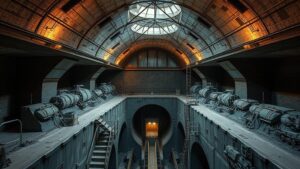Exploring dense forests in the Balkans for remnants of Roman frontier cities.
Exploring Dense Forests in the Balkans for Remnants of Roman Frontier Cities
The Balkans, a region rich in history and natural beauty, is home to dense forests that once served as the backdrop for Roman imperial expansion. This article delves into the exploration of these areas in search of remnants from ancient Roman frontier cities, shedding light on the complexities of their historical significance, architecture, and contemporary relevance.
The Historical Context of Roman Expansion
The Roman Empire, at its height around 117 AD, controlled vast territories, including significant parts of the Balkans. Cities like Singidunum (modern-day Belgrade) and Naissus (Niš) were fundamental outposts of Roman civilization, acting as military bases and administrative centers. development of these frontier cities was not merely for conquest; they shaped trade routes, culture, and infrastructure.
By 395 AD, the Roman Empire had split into Eastern and Western halves, with the Eastern Roman Empire, or Byzantine Empire, remaining influential in the Balkans for centuries thereafter. Understanding this historical evolution is crucial when exploring the remnants of these cities amidst the forests that now envelop them.
Archaeological Significance of the Balkans
The mountainous terrain and extensive forests of the Balkans have, over centuries, concealed many archaeological sites. The challenges faced by archaeologists in these dense areas are significant, as vegetation growth has often protected ancient ruins from destruction but also hindered excavation efforts.
For example, sites such as the Roman settlement of Sirmium, located in present-day Serbia, are hidden within forested areas and provide critical insights into Roman military strategy and urban planning. Excavations have revealed intricate floor mosaics and public baths that highlight the Romans advanced engineering skills.
Key Sights in the Region
When exploring the Balkans, several notable sites warrant attention for their archaeological relevance:
- Felix Romuliana (Gamzigrad): This UNESCO World Heritage site in Serbia features the remains of a palatial complex built by Emperor Galerius in the early 4th century. The site reveals architecture indicative of Roman engineering and design.
- Diocletians Palace: Located in Split, Croatia, this well-preserved palace showcases the imperial lifestyle of the Romans. It served as a fortress and residence for Emperor Diocletian, and its ruins attract thousands of visitors each year.
- Aquileia: Once a major Roman city in northern Italy near the Balkans, Aquileia offers archaeological insight into urban infrastructure with its significant remains of an ancient port.
- Viminacium: Situated near the modern town of Kostolac, Serbia, this archaeological site was another important Roman city that served as a military camp and civilian settlement.
Challenges and Considerations in Exploration
Exploring the forests of the Balkans poses several challenges for archaeologists and enthusiasts alike. Some of these challenges include:
- Dense Vegetation: The thick forests can obscure archaeological sites, making them difficult to locate and excavate.
- Environmental Conditions: Weather conditions can severely impede field research, especially during the winter months when snowfall may cover potential sites.
- Political Instability: Historical conflicts in the region can affect access to certain sites, highlighting the importance of local relations and legal considerations.
Real-World Applications and Conservation Efforts
Efforts to conserve these ancient sites are paramount, as many are under threat from urban development and climate change. Organizations, both governmental and non-governmental, are working on initiatives to protect and promote the cultural heritage of the Balkans. For example:
- The National Institute for the Protection of Cultural Heritage in Serbia: Engages in documentation and conservation of archaeological sites.
- European Union Funding: Several programs focus on assisting the preservation of historical sites impacted by natural disasters and human activity.
Actionable Takeaways
For those captivated by history and archaeology, exploring the dense forests of the Balkans offers a unique adventure. Approach this journey with respect for local cultures and environments. Here are some actionable takeaways:
- Research locations ahead of your visit to ensure access to sites.
- Consider joining guided archaeological tours to enhance your understanding and appreciation of the history.
- Engage with local archaeologists and historians to gain deeper insights into the region’s historical significance.
In summary, the forests of the Balkans are not only natural wonders but also rich in historical remnants of the Roman Empire. By understanding the significance of these archaeological sites and supporting conservation efforts, we can help preserve the legacy of our shared past for future generations.



